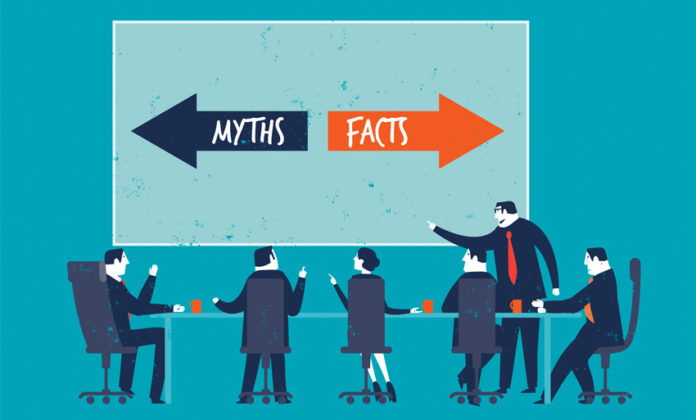The customer experience (CX) has been around as long as there’s been a customer. CX is derived from the feelings your customer has when engaging with your product and service. However, it hasn’t been until more recently (the past decade or so) that CX has really become an integral part of business strategy. A recent Gartner survey found that 89% of companies soon expect to compete on the basis of customer experience.
Times have changed, so has the purchasing landscape and the way we interface with customers. With the raise of the customer experience, there are also myths that have repeatedly surfaced–many of which people still believe to be true. However, it’s time to debunk those myths and separate fact from fiction.
Myth: Investing heavily in AI and chatbots will generate better CX
Chatbots are effective when customer requests are in a specific area where scripted answers will suffice. They also have an instant response time and can operate without a human. However, believing that this technology alone will enhance the customer experience is simply incorrect.
The ‘human touch’ of the CX is still vital. For example, a live agent has the availability to hear a customer’s frustration and respond accordingly. They have the opportunity to ‘go the extra mile’ with a customer, something a chatbot would not be able to do.
Additionally, a customer service rep is able to solve an array of problems, only limited by their own education of products and services. In short, chatbots may have a place in CX, but putting too much weight in their value is missing the human interaction needed to exceed customer expectations.
Myth: NPS is the best way to measure CX
Net Promoter Score, or NPS, measures the customer experience by asking one simple question: “How likely is it that you would recommend our company to a friend or colleague?” While NPS is a very simple way to get feedback from your customers in that it only asks one question, it also only gives you a narrow perspective of customer satisfaction.
Customer satisfaction, or CSAT scores asks customers a series of queries about their experience with five choices from “Very Satisfied” down to “Very Dissatisfied”. The ability to ask multiple questions allows for a business to target specific strengths and weaknesses and giving a more comprehensive view of customer satisfaction.
Additionally, there is the Customer Effort Score, or CES. This measurement looks specifically at the amount of effort a customer had to put into having their needs met, asking questions like “How much effort did you personally have to put forth to handle your request on a scale of 1-5?” While CES may focus on a single element, customer effort, it is a very important element. In fact, 77% of people say that valuing their time is the most important thing a company can do to provide them with good service.
So while NPS is a popular way of measuring CX, it’s not the only way. Figure out what customer feedback is most valuable to your company and use the appropriate measuring tool to get that data.
Myth: You should always be aiming to reduce AHT
Average Handle Time, or AHT is the total average duration of a single call; this includes hold time, talk time, and any other follow-up related to the call. The assumption is that the shorter a person is in communication with your customer service representative, the better. Time is money, right?
However, using AHT as a primary performance motivator gives could give your customer service reps the wrong impression: that it’s about the speed of the call as opposed to the quality of the call.
Important CX opportunities can be missed if there is an incentive to resolve things quickly, such as building rapport, personalization, and a negligence to customer interests. Looking at AHT alone doesn’t necessarily value the customer. Ultimately, the question should be: how do we reduce time with the customer without making them pay for it?
Myth: CX doesn’t impact the bottom line
This may be the biggest myth of them all, and for those companies that believe it are probably already lagging way behind. A plethora of statistics prove that CX directly impacts the bottom line with everything from customer retention to customer acquisition to keeping employees happy.
For instance, 7 in 10 Americans said they were willing to spend more with companies they believe provide excellent customer service. Additionally, customers who had the best past experiences spend 140% more compared to those who had the poorest past experience. In short, a strong customer experience is quickly becoming the number one metric in impacting the bottom line.
Myth: There is a perfect CX program that works for everyone
There is no one-size-fits-all approach to creating the optimal customer experience. The key to knowing what CX strategy or program works the best is knowing your customer’s journey: the touch points, the pain points, and everything in between.
There are certainly statistics that back up the success rate of adding layers of interaction (live chat vs. video chat vs. co-browsing, etc.); however, it’s truly knowing your customer and knowing the best channels to reach them in order to customize the customer experience.
Companies like Glia offer many features to highlight and optimize CX, but it takes empowered employees to deliver on those features. In short, the ‘perfect’ CX program doesn’t exist, only the CX program that best fits your company’s needs.
In Conclusion
The bottom line throughout all these myths is that in order to deliver the best possible customer experience, you need to know your brand and your customer. The journey to reaching these high value customers may seem daunting, but the time and energy invested in perfecting your company’s CX can pay off big in the long run. Are there any other CX myths that you feel should be debunked?





